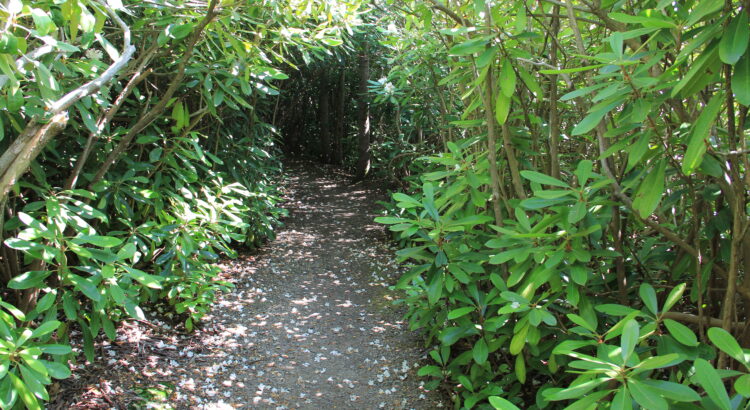By Ted Lenk
Do you remember way back in June 2024 when all the cultivated Rhododendrons in this region were in full bloom? It was yet another amazingly prolific season, this year seemingly more beautiful than ever. The native Rhododendron maximus (also known as “Great rhododendron”) at Rhododendron State Park in Fitzwilliam, NH are still waiting for their normal bloom time to come-that is, mid-July. You may see an occasional early flower cluster that has opened up here or there. Did the heat wave in the last part of June speed things up a bit? Probably.
A preliminary inspection of the grove indicates a light bloom for this year, which unfortunately for us tourists, is not at all unusual. Indeed, the last time there was more than 40% of the potential bloom (as if all the many branches had flowers on them) was in the mid-2000s
Because R.(Rhododendron) maximus is an “unimproved” species and not a hybridized variety of rhododendron (most of the ones used in landscapes and sold in nurseries are hybridized and bred to be very showy and colorful), they will never be as showy and prolific as the cultivated types. It is rare to see such a full blooming as in 2006. Truly a spectacular show, it was amazing to see.
How are these Rhododendrons different?
It takes a lot of energy for any plant to make flowers followed by seeds-all in the name of reproducing itself. R. maximus never has much energy to spare, given that it evolved to thrive in shade as well as acid, wet, low nutrient soil. Instead of making seed this plant has developed a strategy to procreate itself asexually (also known as cloning) which cuts way down on the need for making flowers and the resulting seeds, thereby saving energy that can now be used for growing out. The drawback of this method of reproduction is that it makes an exact replica, or in other words, a genetic copy, of the previous generation. The result being that the genetic pool becomes limited. On the other hand, the great advantage of this seedless reproduction is that it requires only the most basic and readily available components-water, soil and light.
If you were to closely inspect the branches lying on the moist ground, you might see a few filamentous roots that have established themselves on those branches by taking advantage of the moisture and nutrients there. This is a great example of asexual reproduction. Plants that do this could be called “walkers” because of the way that they first spring up and then fall over, taking root in order to spring up and fall over again, thus “moving” across the landscape. There are many plants that do this very well. Sometimes we humans think of them as troublesome, and sometimes we use them to our advantage. But I digress…
It may well be that the result of this method of self-cloning is that the genetic material of most of the R. maximus found in this grove is very similar. As far as I know, this theory has never been tested.
However, in contradiction to this theory, there are some pure white flowers in the grove, while in most areas the flowers have a pinkish tinge, sometimes permanent.
To clarify this observation, almost all the flowers in the grove will start out with a pinkish background that fades as the flower matures.
But, as previously stated, some flowers will have no pink at all from the very start, even in the flower bud. This difference in flower color may indicate a genetic variation between some plants. Or, it could be due to nutritional variation in the soil. Or extra moisture. Or something that nobody knows about. This seems to be the most plausible idea yet.
Whatever the show is this year, you can always count on the biting insects at the grove. Some days they are thicker than other days. It all depends on I don’t know what. Maybe the weather. Come prepared, and you will find out when you get there. And before you set out on the trail, please visit the information kiosk at the trailhead so as to see what is new at the park. Rhododendron State Park

